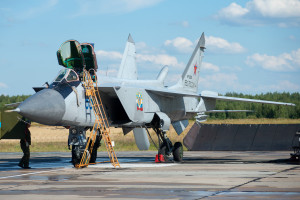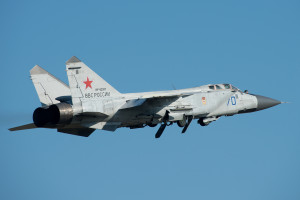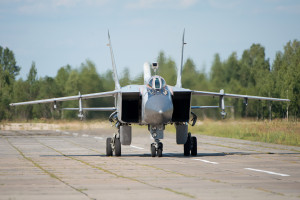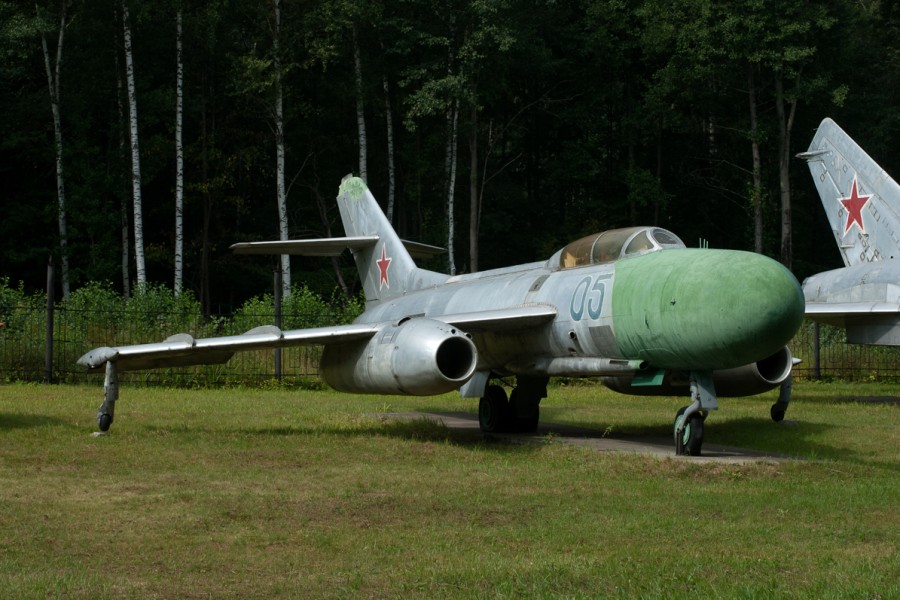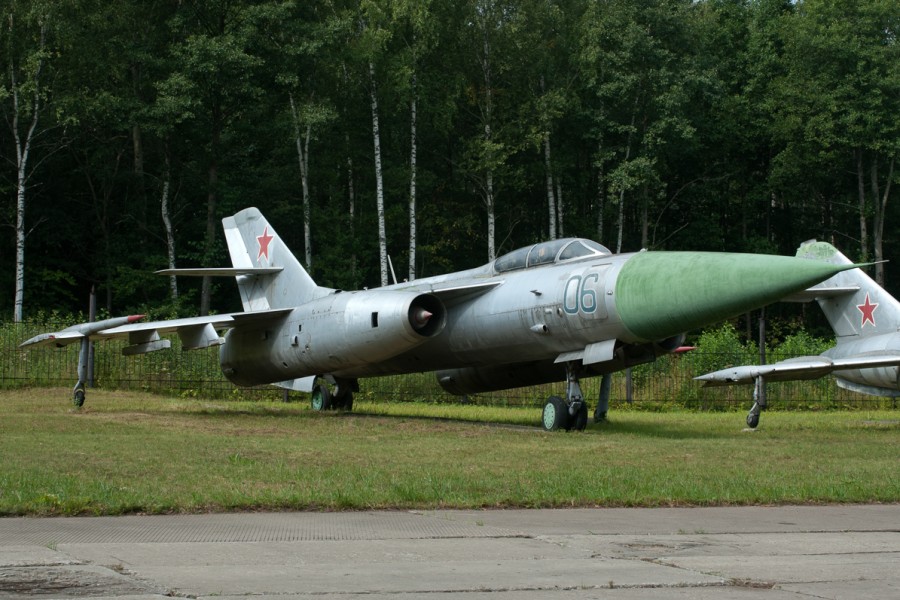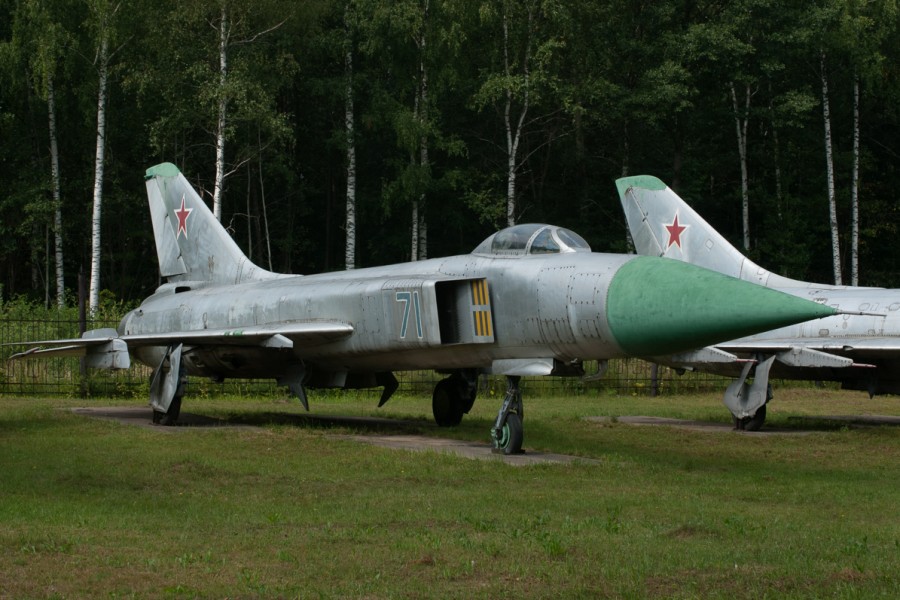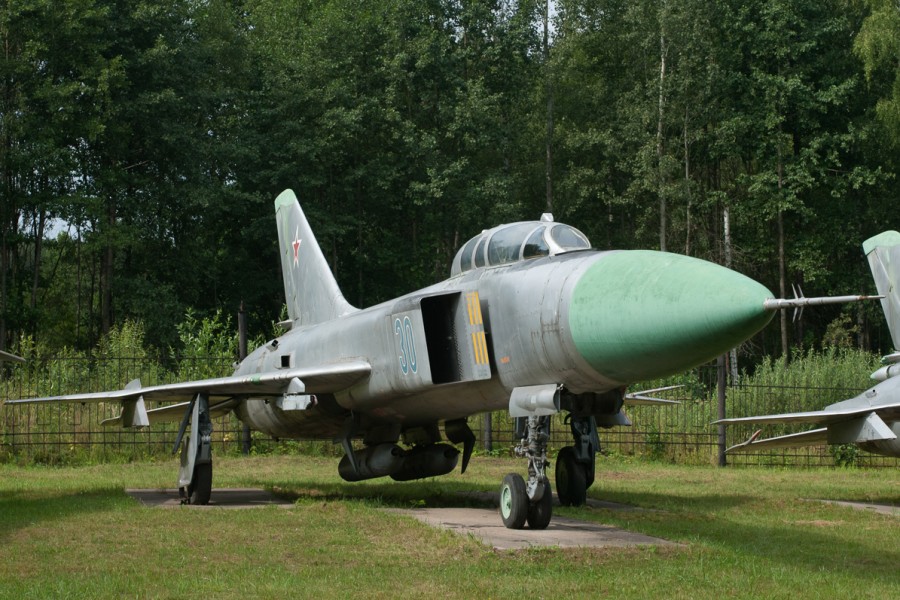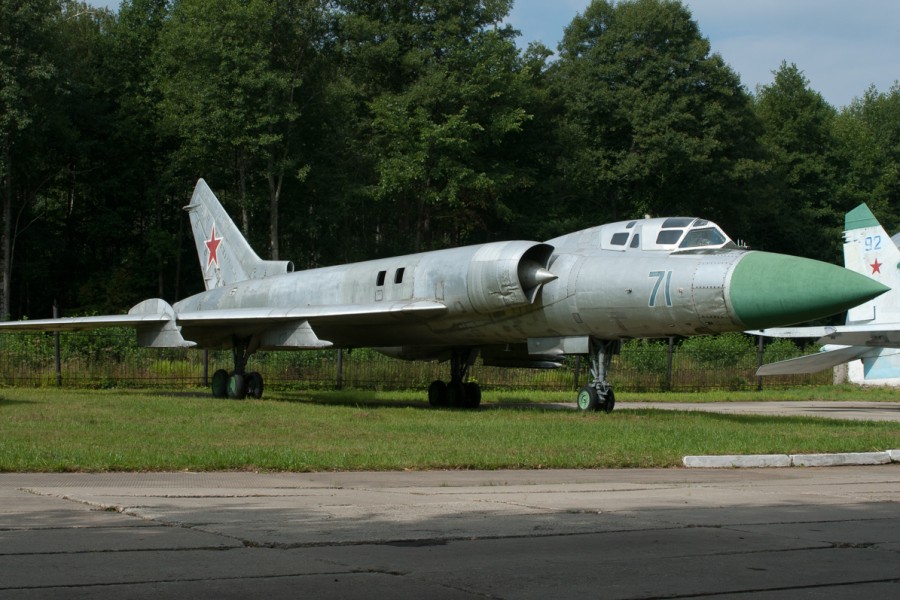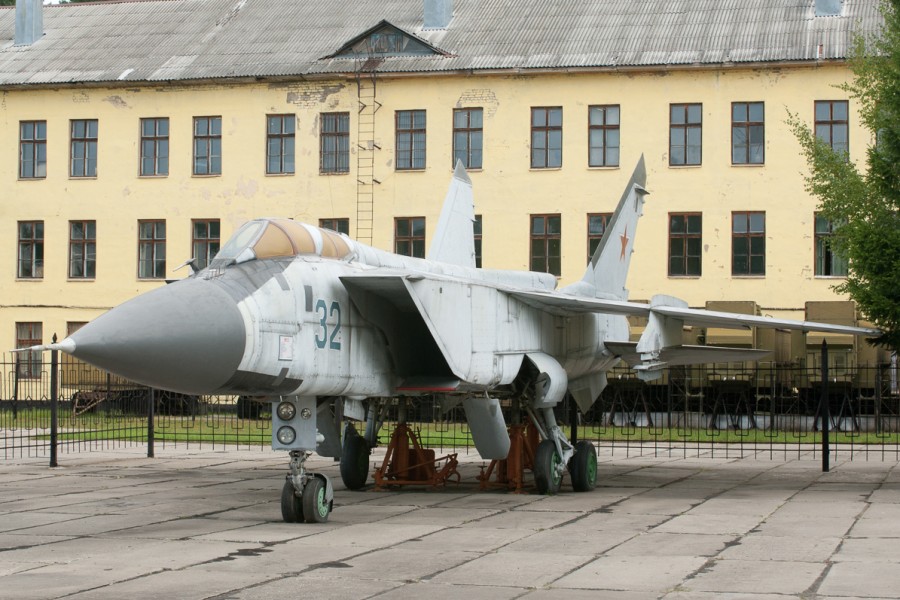The MiG-31: Foxhounds of Savasleyka
Article and Photos by Patrick Roegies
Introduction
S
Origin
Savasleyka Air Base was constructed between 1953 and 1954 and was appointed as the Aviation Training Center of the Air Defence Forces, which was previously located at Seyma Air Base, near Volodarsk. The center moved to Savasleyka in December 1953, when the first Regiment appointed to Savasleyka Air Base was the 2nd Independent Aviation Training Regiment. This Regiment was originally activated on 20th February 1947, at Seyma Airbase, as the Red Banner Educational Combat Center PVO.
The 2nd Independent Aviation Training Regiment was originally formed as the 166th Reserve Fighter Regiment (IAP) in July 1940, in the Gorky region, near the village of Savasleyka, as an Independent Reserve Regiment. Based on the directives of the General Staff of the Red Army on 30 June 1941, the 166th IAP was reformed into the 2nd Reserve Regiment and was sent to the front to participate in the patriotic war. Between 1941 and 1945, the Regiment retrained aircrews for both the Air Force and Navy aircraft types LaGG -3, La -5 and La-7. In total, the Regiment prepared 106 Regiments for battle and retrained 1,003 pilots and approximately 5960 engineers and 5959 technicians.
Post War Years
After the end of the war on 29th December 1945, the appointed task of the 2nd Reserve Regiment was altered when it was reformed into an Independent Aviation Training Regiment. The two main tasks of the regiment were to perform the research and development of tactics for the latest state-of-the-art aircraft and for the training and conversion training of aircrews. In August 1946, the personnel of the Regiment began with their appointed tasks with the new Yakovlev Yak-15 “Feather”. Only one year later, the unit transferred to the Yak-17, and in December 1946, 11 pilots performed a formation flight using the Yak-17, from Moscow to the Gorky region, when the Regiment was relocated to its new home at Seyma Air Base.
On 20th February 1947, the regiment was converted into a Training Center of the Air Force when the entire Regiment moved to Seyma Air Base and began the development of tactics for the new Mikoyan-Gurevich MiG-9. During that same year, the regiment was reorganized and renamed the 148th Air Defense Training Center (148 TsBP i PLS). It was still responsible for conversion training of pilots, developing tactics and performing research and development for the latest aircraft types. As a result, on 28th February 1950, the Center transformed into an air Defense Center of the Soviet Air Forces.
One year later, on 29th August 1951, the 148th TsBP i PLS began the service testing of 40 MiG-15’s. This was followed in 1953 by the development of new combat tactics for the PR1 radar gun equipped MiG-17P. In December 1953 the Regiment again relocated to Savasleyka Air Base where construction had only just been completed. The structure of the 148th TsBP i PLS was altered and resulted in the activation of two new Training Regiments and the relocation of one existing Training Regiment. In 1952 the 594th Aviation Fighter Training Regiment (UIAP) and the 615th Aviation Fighter Training Regiment (UIAP) were activated at Savasleyka and were complemented by the 592nd Aviation Fighter Training Regiment (UIAP), originally activated at Klin Air Base in 1952 and relocated to Savasleyka Air Base in 1954.
From 1954, the 615th UIAP commenced development of combat tactics, including the training program for the Yak-25, performing research to increase its combat capabilities. From 1955 to 1960, the 148th TsBP i PLS also admitted foreign students at the Center for flight and engineering. Staff from the Air Forces of Czechoslovakia, East Germany, Poland, Hungary, Cuba, Romania, Bulgaria and Albania were trained in the latest tactics on aircraft types that had been integrated into their national Air Force inventory. Since there was a huge increase in the development and construction of new fighter, bomber and fighter interceptor aircraft. During the post war and cold war period, the inventory of aircraft based at Savasleyka changed on a regular basis, meaning the staff had to adapt quickly to new aircraft and new techniques, and to quickly gain experience on the new aircraft in order to research and develop new tactical concepts.
In 1958 the 148th TsBP i PLS explored the possibility of using the Yakovlev Yak-25 for combat at low altitude, and, subsequently, developed the recommendations, which were then implemented into the Air Force. In 1959, the Center also developed and mastered a new aerial combat system for the Sukhoi Su-9 interceptor which had arrived that same year at Savasleyka.
With the arrival of the Su-9 in 1958, the latest generation of fighter interceptor, the 148th TsBP i PLS explored the possibility of intercepting targets during nighttime that same year. In 1960, the first Mikoyan-Gurevich MiG-19’s arrived at Savasleyka and in 1963 the 594th UIAP was equipped with the Yakovlev Yak-28P. One year later, Savasleyka Air Base saw the arrival of two more new fighters, the Sukhoi Su-11, and the Tupolev Tu-128. The Tu-128 being the only long-range fighter interceptor the Tupolev design bureau had produced up until this date. The Sukhoi Su-11 was replaced by the Su-15, from 1967 forward. During that same year, the name of the regiment was changed from 148th Air Defense Training Center to 148th Center for Combat Employment and Retraining of Personnel PVO. In the following years the center would specialize in developing the tactics for fighter interceptors appointed to the PVO.
Focus Towards Fighter Interceptors
The first Mikoyan-Gurevich MiG-25’s were delivered to Savasleyka Air Base in 1968, and the unit had to develop and master a new missile system for the MiG-25P fighter interceptor. In 1967, the Gorky plant built a first series of interceptors, designated E-155P7, -P8 and -P9 with the E-155P10 and -P11 following in 1968. The standard for series production became the E-155P6. All of the above aircraft took part in the S-155 interceptor complex’s joint official testing that was initiated in December 1965. The first phase of the testing was completed in November 1968 resulting in the preliminary approval for the commencement of series production. In line with that approval, the interceptor platform was officially designated the MiG-25P. Also in November 1968, phase B of the joint official testing commenced and was successfully completed by May 1970. Not long before that, first series-built MiG-25P’s were assigned to the 148th TsBP i PLS with the Air Defense Forces Aviation Regiments commencing transition to the new aircraft later in 1970. Based on the results of the Training Center, the USSR Council of Ministers resolution of 13th April 1972 authorized the inclusion of the MiG-25 interceptor as part of the MiG-25-40 (S-155) interceptor platform, into the operational inventory. The MiG-25-40 (S-155) aircraft and missile interceptor comprised of the MiG-25 aircraft equipped with the Smerch-A radar and Polyot-1I navigation suite and armed with four R-40 medium-range radar (R-40R) and IR (R-40T) homing air-to-air missiles. It also featured the Lazur-M set as part of the Vozdukh-1 ground command guidance system.
The year 1970 also saw the introduction of another fighter interceptor the Sukhoi Su-15TM, followed closely in 1971 by the Mikoyan – Gurevich MiG-23, which remained at Savasleyka Air Base until 1980. During 1971 the center began the study of the combat capabilities of the MiG-23, which were successfully completed by 1974.
The Garrison also opened a unique museum on 21st October 1973 where a fine collection of the country’s air defense aircraft were exhibited. In this museum there are thousands of interesting pictures, information archives, pilots flying books, pennants, awards, served in the garrison and other exhibits.
During 1980, the Center for Combat Employment and retraining of personnel PVO was reorganized and resulted in the disbandment of the 592nd UIAP and the activation of the 142nd Independent Transport Aviation Squadron. In that same year, the first Mikoyan – Gurevich MiG-31’s were delivered to Savasleyka, and are currently still based there. Also, during that same year, the Center received its first Su-27 aircraft and started development and research into its combat capabilities. By 1984, the 615th UIAP was fully equipped with the Su-27.
In 1985, the center for combat employment was the first to master the Sukhoi Su-27 (T-10). During this time, the center was very often visited by test pilot Victor G. Pugachev, who was a pioneer for the development of this aircraft.
Arrival of the MiG-31
During the spring of 1980, the first production MiG-31’s arrived at the 148th Air Defense TsBP i PLS at which time the unit commenced the training and retraining of pilots by conversion training at a new aviation interception complex. By the end of March, four pilots had successfully completed their theoretical training. Soon after, the unit started to provide conversion training for the 786th IAP Regiment, based at Pravdinsk, also situated near Gorky. The conversion training of 786th IAP was completed by 23rd February 1981, when the unit became fully operational as a fighter interceptor unit. With conversion training of the 786th IAP completed, the 174th Pechenegskogo GIAP based on the Kola Peninsula in Moncherosk was the next unit to start the conversion training. In the fall of 1982, new tactics were developed and crews of the 174th and 786th Regiments returned for retraining of these new tactics. During September 1983, the 777th IAP, based at Sakhalin Air Base in the Far East, was the next Regiment to receive the MiG-31 and start their conversion training. The following year, conversion training commenced for the 763rd IAP, based at Komsomol in the Tyumen region. By the end of the 1980’s, MiG-31’s were operationally deployed at more than 20 air bases within the territory of the Soviet Union. In addition to these regiments, the following front line regiments were also equipped with the MiG-31 and training for these units commenced from 1985 forward:
| 518th IAP | Regiment Talagi Air Base | near Arkhangelsk |
| 865th IAP | Regiment Elizovo Air Base | Kamchatka |
| 513th IAP | Chuguevka Air Base | Primorye |
| 64th IAP | Omsk North Airport | |
| 350th IAP | Bratsk Air Base | |
| 180th IAP | Gromovo-Sakkola Air Base | Leningrad Region |
| 83rd IAP | Rostov on Don Airport | |
| 790th IAP | Kalinin | Tver |
| 764th IAP | Bolshoye Savino Air Base | near Perm |
| 712th IAP | Kansk South | |
| 57th IAP | Alykel Air Base | near Norilisk |
| 153rd IAP | Morshansk Air Base | Tambov Region |
| 72nd GIAP | Amderma Nenets | |
| 356th IAP | Semipalatinsk Airport | Kazakhstan |
The Turbulent Nineties
The collapse of the Iron Curtain in the early 90’s eventually meant the end of the Warsaw Pact. As a consequence, numerous Aviation Regiments deployed in Warsaw Pact nations were withdrawn and returned to Russia. Because of this, a lot of units that were withdrawn were now surplus. A large number of these Regiments were disbanded and their aircraft were either transferred to other units or put in long term storage. For Savasleyka Air Base, this meant a change in the organizational structure, and as an effect, the 615th UIAP was disbanded in 1990 and only two years later the 594th UIAP was also disbanded as a result of both budgetary cutbacks and the ceasing of development of new aircraft. In that same year, the 54th GIAP was transferred from Vainode Air Base in Latvia to Savasleyka. This unit used to be equipped with the Su-15TM but transferred to the Su-27 in 1987. Later, the regiment also received a number of Su-30’s which were delivered between 1994 and 1997.
Additionally, the 786th IAP based at Pravdinsk Air Base in the Gorky region was integrated into the 148th TsBP i PLS structure. This unit had already been equipped with the MiG-31 since 1981. The 142nd Independent Air Transport Squadron still remained at Savasleyka Air Base until it was finally disbanded in 1998.
In 1991, the 738th IAP based at Sary Shagan was one of the latest Air Defense units that received the MiG-31. In addition after the collapse of the Soviet Union in 1993 the 458th GIAP based at Savastiya – Kotlas Air Base in the Arkhangelsk region obtained MiG-31’s from disbanded Regiments.
In the meantime, the crews of the 148th Air Defense TsBP i PLS continued to develop new tactics and testing new innovations with the Su-27 and MiG-31 aircraft. In 1993, the crews of the center managed to perform the first air refueling flight on the MiG-31 and, in 1994, this was repeated for the Su-27. Given the lack of funding, the research and development activities decreased rapidly at Savasleyka in the next few years to follow.
Mastering the Hound
The combat capabilities of the MiG-31 were far superior to the conventional interceptors Yak-28P, Su-15TM, Tu-128 and MiG-23P. In comparison to these second generation fighters, which were easy to maintain and relatively simple, the armament of the MiG-31 was much harder to operate and maintain. As a result, the introduction of the MiG-31 to operational Aviation Regiments was postponed several times. For many, this was a derisory level of education, especially for officers that graduated from the academy more than 15 years ago. For maintenance personnel, the aircraft showed many technological systems that compared to the earlier interceptors as the Yak-28P but were much more complex and integrated in a huge aircraft. Flying the MiG-31 required training and experience since the aircraft weighs 41,000 kg with a normal load (approx. 90,390 lbs) and requires a high landing speed of 280 km/h (approx. 174 mph). In the case of a recovery being performed with a lot of remaining fuel, landing the aircraft is even tougher. In the case of a single engine failure, the aircraft consumes approximately twice the amount of fuel and it could prove difficult to reach the intended destination.
The majority of the more experienced pilots found the psychological aspects uncomfortable and most of them had trouble mastering the new techniques of piloting. Not all of the pilots had the patience for proper theoretical training at their home base. Conversion training provided to the 763rd IAP and 350th IAP regiments proved to be slightly easier due to majority of pilots and technicians having only recently graduated. However, the conversion to the MiG-31 also showed some difficulty in these cases.
Since the MiG-31 had only recently been developed the aircraft still showed some early glitches. During the military commissioning trials conducted by the 786th IAP regiment based at Pravdinsk, the pilots regularly returned from flights with miscellaneous equipment failures. Early production series aircraft showed trouble with the air conditioning system for the cooling of the turbines. Similar experiences were met in other Aviation Regiments, however, the reasons remained unclear. It was only after an accident on 24th September 1985 that the reason of these malfunctions could be traced to the turbine blades, which failed due to poor workmanship. The entire fleet was temporarily grounded and examined. Upon examination, all dangerous defects were removed, and the cooling turbines were modified by reinforced armored steel cables, which eventually lead to a redefinition of the design.
Unfortunately, another issue, fires in the power plant, were not solved by this modification, and on 8 August 1988, a sortie flown by the 174th GIAP over the Barentz Sea resulted in a fire, which the pilots were unable to extinguish during flight. The experience and patience of the crew however enabled them to land the aircraft safely. It took another 2 years to solve all the remaining problems.
Development Setbacks
Beginning in 1993, funds decreased rapidly and, as a result of this sharp decline in funding, the bulk purchase of new MiG-31 aircraft was impossible. Nonetheless, there was an urgent demand for additional fighter interceptors. In 1997, this lead to the initiation of a development program with the purpose of modernizing the existing MiG-31 fleet and the upgrading of them to MiG-31BM standard. This modernized version of the MiG-31 was to possess significantly increased combat capabilities. By upgrading the avionics, the new MiG-31BM had to be equipped with an armament control system, capable of attacking both targets on the ground and in the air. Also, the modernized version had to be able to detect potential targets at almost twice the range compared to the MiG-31B.
On board equipment also had to enable effective interaction with the anti aircraft air defense surface to air missile systems. The MiG-31BM would be virtually used as a flying command center coordinating the actions of other fighters in the area, which were equipped with a less sophisticated radar system. The interceptor was now able to direct launched missiles fired from other fighters and direct them to the selected air targets. These developed tactics increased the effectiveness of an entire fighter group.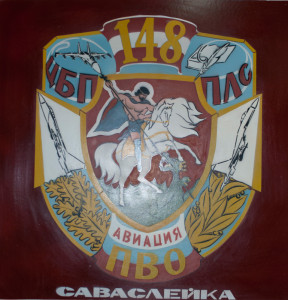
JSC Russian Avionics developed a new arrangement for the modernized MiG-31BM. The main disadvantage of the initial layout design was the lack of information concerning the tactical situation a pilot could obtain. The pilot was also unable to share the information the navigator had. In the new design, a new 6×8 inch multi-functional LCD was integrated in the front cabin on the right side of the control panel similar to the MiG-29SMT’s general arrangement.
More significant, were the changes for the navigator, who possessed 3 indicators, which could display the most diverse tactical, navigational, radar, images of the television sensor or guided weapons information. Also, there was an addition of Head-Up Displays (HUD) replacing the former PPI displays. Two operational MiG-31’s transferred to the design bureau were used to perform the required tests. The first modified aircraft was completed in 1998 and was presented on 12th January 1999. After the presentation of the first MiG-31BM, it was presumed that all the existing MiG-31’s would be upgraded and submitted to the modernization program. The lack of funding and the lack of necessity to modernize the entire fleet lead to a long delay.
Rebirth
In 2000, the Training Center at Savasleyka remained with the 54th GIAP, operating 39 Su-27 and Su-30’s and 8 MiG-31’s. In 2001, the 148th Combat Training Center was decommissioned, but Savasleyka Air Base kept its original appointed task of retraining pilots and performing research and development of new tactical concepts. The 54th GIAP remained at Savasleyka Air Base until it was decommissioned in 2005, which also resulted in the departure of the Su-27 and Su-30’s. The Airbase was appointed the name of 3958th Reserve Air Base and still had control over the MiG-31s that remained at Savasleyka.
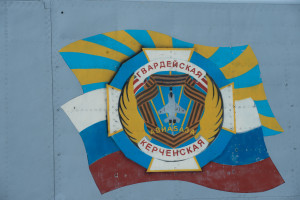 The 4th Center deployment and retraining of pilots of the Tactical Aviation and the 1080th Aviation training Center were reformed on 14th February 1997, and merged into the 4th Center deployment and retraining pilots of the Tactical Air Force based at Lipetsk Air Base. Following this example, on 1st September 2001 were the 148th Combat Training Center and the 32nd Warfare Center employment and retraining of pilots of the Air Force which were reorganized and merged with the 4th Center Deployment and Retraining Pilots of the Tactical Air Force and, as a result, the center was renamed to 4th Center Deployment and Retraining Pilots Air Force (TsBP i PLS) on 15th September 2001. Only one year later on 1st September 2002 the 3958th Reserve Air Base Savasleyka was subordinated to the 4th Center Deployment and Retraining Pilots Air Force. During the transition to Lipetsk, the 148th Center was decommissioned and ceased to exist ending a rich history of pilot training and tactical development.
The 4th Center deployment and retraining of pilots of the Tactical Aviation and the 1080th Aviation training Center were reformed on 14th February 1997, and merged into the 4th Center deployment and retraining pilots of the Tactical Air Force based at Lipetsk Air Base. Following this example, on 1st September 2001 were the 148th Combat Training Center and the 32nd Warfare Center employment and retraining of pilots of the Air Force which were reorganized and merged with the 4th Center Deployment and Retraining Pilots of the Tactical Air Force and, as a result, the center was renamed to 4th Center Deployment and Retraining Pilots Air Force (TsBP i PLS) on 15th September 2001. Only one year later on 1st September 2002 the 3958th Reserve Air Base Savasleyka was subordinated to the 4th Center Deployment and Retraining Pilots Air Force. During the transition to Lipetsk, the 148th Center was decommissioned and ceased to exist ending a rich history of pilot training and tactical development.
With the start of a new century, the Russian economic situation improved significantly and the defense budgets started to increase, instead of further cut backs as had been the case for the last 10 years. With the increased budget, the basic types of front line aircraft were to be upgraded and modernized. For the MiG-31 this meant that RAC – MiG re-offered the already conceived modernization of the existing MiG-31 fleet to MiG-31BM standard using the experiences and technology from the modernization of the export fighters Su-30MK, MiG-29K and MiG-29SMT. The developers redeveloped the same two MiG-31BM earlier submitted to the modernization program in order to transform the new Foxhound into a multi-role fighter-interceptor.
The budgets, however, were insufficient to upgrade all the aircraft within the operational fleet of the Russian Air Force. In effect, the fleet was reduced and reorganizations took place in order to boost the Air Force into the new century as a lean and mean Air Force. The number of aircraft were to be reduced, but funds were to be reserved for maintaining the remaining aircraft, properly train pilots and enable the operational pilots to perform sufficient hours on their aircraft at their operational Air Bases.
Given the new funding for modernization of the fleet the MiG-31BM project was relaunched. The two already modified aircraft went back to the design bureau and were subjected to a redesign based on the latest available technology.
The Savasleyka Air Base Museum, located at Savasleyka Air Base, has over 24 specimens of aircraft covering numerous eras in Russian military aviation history.
After the completion of the first aircraft, which carried the tactical code 60, it was used for an extensive test cycle. The outcome of the test program showed a significant improvement of the combat effectiveness and it was concluded that the modernized MiG-31BM became a worthy 5th Generation fighter interceptor adversary. The aircraft was presented in 2007 and, in the spring of 2008, the second modernized MiG-31BM at Nizhny Novgorod was completed.
Both aircraft were transferred to Savasleyka Air Base upon completion, where they were submitted to performance evaluations, which were completed successfully. By spring of 2009, the number of MiG-31BM‘s present at Savasleyka doubled. In the meantime, long-term contracts for the modernization of the MiG-31 were ordered by the Ministry of Defense from 2006 forward, which were delivered to active Air Defense Regiments from 2009. The pilots of these regiments were temporarily deployed to Savasleyka Air Base in order to be retrained to operate the modified aircraft and gain experience concerning its improved capabilities and increased tactical advantages. After the delivery of the first two aircraft in 2008, an additional two followed in 2009, which were also delivered to Savasleyka Air Base. More deliveries took place in 2011 when 15 aircraft were delivered to the Air Force. In July of that same year, air to air refueling training exercises commenced. By December 2010, the Russian Ministry of Defense signed a contract for Russia’s United Aircraft Corporation to upgrade an additional 60 aircraft to MiG-31BM standard between 2012 and 2020, with initial deliveries of 10 aircraft taking place in 2012.
From 2009, a number of organizational changes were initiated which resulted in the current organizational structure. On 20th August 2010, the 344th Center of Deployment and Retraining of Pilots of the Army Aviation based at Thorzok, the 924th Center of Inter-specific Deployment and Retraining for Unmanned Aviation Personnel based at Kolomna, the 43rd Guards Center for Deployment and Retraining Pilots for Long Range Aviation based at Ryazan and the 610th Center Deployment and Retraining Pilots for Military Transport Aircraft based at Ivanovo, including all their subordinated units, were placed under central subordination (ChTsP) Moscow Command with the headquarters at Lipetsk Air Base. The 4th Center Deployment and Retraining Pilots Air Force (TsBP i PLS) was renamed on 15th March 2011, as the 4th Center of training of aviation personnel and military trials of the Ministry of Defence (4GTsPAV i VI).
Integration into a Modernized Air Force
By 2010, modernization programs were also in progress for the Mikoyan – Gurevich MiG-29 and the Sukhoi Su-24, Su-25 and Su-27 aircraft.
Besides this modernization program, the Air Force is also accepting new aircraft including Sukhoi Su-34 and Su-35 fighter aircraft, the Yakovlev Yak-130 advanced trainer, Kamov ka-52 and Mil Mi-28 helicopters. It is intended that the Su-34’s will eventually replace the remaining Su-24 fleet.
The 3958AvB Savasleyka has only one Aviation Group (AvGr) which operates 12 MiG-31BS/BM aircraft. These aircraft have been provided with a blue code and have all been registered with a Russian Federation (RF) serial number in the range of RF-93xxx to RF-93xxx. The MiG-31BS aircraft have been appointed the tactical codes 70 and up and the MiG-31BM aircraft have been appointed the codes 91 and up.
Patrick Roegies is born and raised in Tilburg, the Netherlands and currently resides in Sittard in the south of the Netherlands where he lives with his wife Joyce. Patrick graduated from a technical study at the HTS in Tilburg in 1997. He currently works as a head of an equipment engineering department in the south of the Netherlands.
His passion towards aviation started at the age of 7 in 1977 when his father took him to nearby Gilze Rijen Air Force base where he witnessed his first howling F-104 Starfighters which were practicing and as a result he got addicted immediately. The F-104’s were present in order to determine a tactic to create a diversion for the “train highjack” which was going on in the Netherlands at that time. The F-104’s were meant to create a diversion by performing an overshoot, kicking in the afterburner directly over the train, creating confusion with the hijackers and enabling the police to master the hijackers. This action has actually been performed and worked.
This is when his passion towards aviation was born. He got permission from his parents to visit the airbase every free hour he had and his father showed him the way by bicycle. Patrick got his first camera in 1984 which was a Canon T50 and shot Kodachrome 64 slides of mainly military aircraft. He changed his gear in the mid-nineties to Nikon and is a Nikon user ever since.
When Patrick obtained his driver license in 1989 he started to visit airbases all over Europe and from 1997 onwards he made worldwide visits to military airbases.
In order to further professionalize his work as an aviation photographer and journalist he started to write military aviation related articles based upon his visits to various nations and their Air Forces. He managed to publish his first article in 2003 and increased the numbers of publications every year.
Patrick can be reached at: [email protected]



